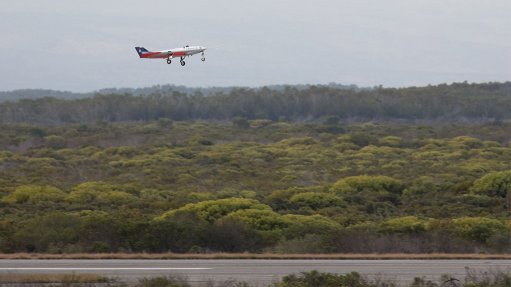
The Sagitta UAV in flight at Overberg
Photo by: Airbus DS
South Africa’s Overberg Test Range was the site of the first flight of the Airbus Defence and Space (Airbus DS) Sagitta jet-powered unmanned air vehicle (UAV) demonstrator, the European company announced on Tuesday. The aircraft, a flying-wing design, flew autonomously over the test range (which is owned and operated by South Africa’s State-owned Denel defence industrial group) for seven minutes, following a pre-programmed route.
The UAV has been developed in a cooperative programme between Airbus DS and a number of institutions in Germany: the German Aerospace Centre (better known by its German initials, DLR), the University of the Federal Armed Forces, the Ingolstadt University of Applied Sciences and the Technical Universities of Chemnitz and of Munich. This programme was part of the national Open Innovation/Sagitta initiative, which was started by Airbus in 2010, and intended to create leading edge technologies for UAVs.
“With Sagitta’s first flight, we have proved just how successful a cooperation between industry and academic partners can be in the area of basic research,” enthused Airbus DS engineering head Grazia Vittadini. “We are increasingly shifting our focus towards these kinds of innovative concepts, in particular for the development of UAVs, so that we can develop products quickly and efficiently for a growing market.”
The Sagitta airframe has dimensions of 3 m by 3 m and was built to a scale of 1:4. The airframe is entirely made out of carbon fibre composite (itself made using several new production processes). Except for its brakes, it uses no hydraulic components but is controlled using electro-mechanical actuators. Its low observability is the result of its shape. Its power plants are two 300 N turbines and it has a maximum take-off weight of 150 kg.
The project began with a feasibility study of the flying wing layout. Design criteria for the UAV included a high level of autonomy, low observability, and the ability to vary mission profiles. Academic and industrial research approaches were adopted and then further developed by the inter-institutional research team, leading to industrial application solutions.
This process was, during the development stage, facilitated by Airbus DS. The company also made available its facilities at its Military Air Systems Centre in Manching, Germany, needed to integrate the technologies into the demonstrator UAV. Even if it never enters production, the Sagitta will give Airbus DS and its collaborators valuable experience for developing new technologies for UAV flight systems and to develop future products for manufacture, the company pointed out.